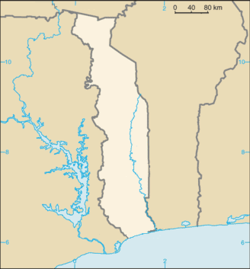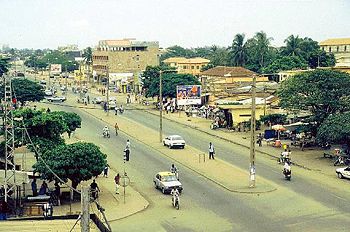Lomé
2008/9 Schools Wikipedia Selection. Related subjects: Africa; Cities
| Lomé | |
| Panoramic view of Lomé | |
| Location of Lomé in Togo | |
| Coordinates: | |
|---|---|
| Country | Togo |
| Region | Maritime |
| Population (1998) | |
| - Total | 700,000 |
Lomé, estimated population 700,000 (1998), is the capital and largest city of Togo. Located on the Gulf of Guinea, Lomé is the country's administrative and industrial centre and its chief port. The city exports coffee, cocoa, copra, and palm kernels. It also has an oil refinery.
History
The city was founded in the eighteenth century by the Ewe people. In 1882, the village, known then as Bey Beach, became a major trading centre with the arrival of Chico and Octaviano Olympio as agents for the British trading firm A. and F. Swanzy.
Bey Beach became the capital of Togo when the German rulers transferred capital status from Aneho in 1897. The city then grew quickly until it was taken by the French Army in 1914 during World War I.
Demographics
| Demographic evolution of Lomé |
| 1892 : 1 500 inhabitants |
| 1896 : 2 000 inhabitants |
| 1900 : 3 000 inhabitants |
| 1904 : 4 000 inhabitants |
| 1907 : 6 000 inhabitants |
| 1911 : 8 000 inhabitants |
| 1930 : 15 000 inhabitants |
| 1938 : 18 000 inhabitants |
| 1950 : 33 000 inhabitants |
| 1955 : 43 000 inhabitants |
| 1960 : 85 000 inhabitants |
| 1970 : 186 000 inhabitants |
| 1981 : 375 499 inhabitants |
| 1990 : 450 000 inhabitants |
| 1997 : 573 000 inhabitants |
| 2006 : 737 751 inhabitants |
Attractions
Lomé lies in the extreme south west of Togo, up against the Ghanaian border. Attractions in the city include Lomé Grand Market, the Togo National Museum in the Palais de Congrés, a fetish (voodoo) market, Lomé Cathedral, beaches and the former wharf.
Education
The University of Lomé (previously called University of Benin) is located in Lomé Tokoin Campus.
Transportation
The city is served by the Lomé-Tokoin Airport. The tallest building in Lomé and in all of Togo is the 2 Fevrier Sofitel Hotel building. The former railway line to Blitta runs from the city.
Neighborhoods
Neighborhoods in Lomé include Ablogamé, Adawlato, Amoutivé, Bé, Dékon, Forever, Kodjoviakopé, Noukafou, Nyékonakpoé, Tokoin and Xédranawoe.
Neighbourhoods in the north of the city are almost separated from the centre by a lagoon.
Greater Lomé
Cities and towns in the Greater Lomé Metropolitan Area include: Aflao (Ghana), Agbalépédogan, Akodésséwa, Anfamé, Baguida, Kanyikopé, Kélékougan, Lomé II, Totsigan and Totsivi.
International agreements signed in Lomé
Lomé Convention
The Lomé Convention is a trade and aid agreement between the European Union (EU) and 71 African, Caribbean, and Pacific (ACP) countries. It was first signed on February 28, 1975 in Lomé.
Lomé Peace Accord
The Lomé Peace Accord was a peace agreement between the warring parties in the civil war in Sierra Leone. With the assistance of the international community, Sierra Leone President Ahmad Tejan Kabbah and Revolutionary United Front leader Foday Sankoh signed the Peace Accord on July 7, 1999. However, the agreement did not last and the Sierra Leone Civil War continued for two more years.
Sister Cities
 Duisburg, Germany
Duisburg, Germany Shenzhen, China
Shenzhen, China Taipei, Taiwan
Taipei, Taiwan Bay City, Michigan, United States
Bay City, Michigan, United States



